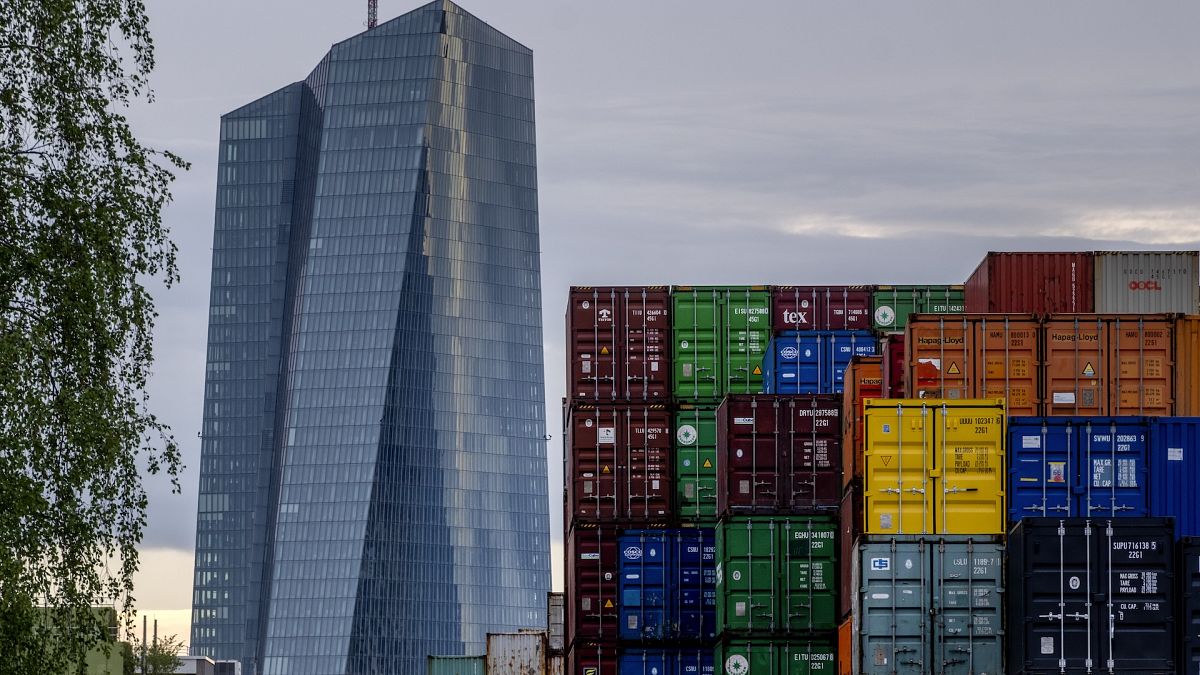During the opening stage of the Russian invasion, Ukraine’s army devastated Russian forces through the use of drones, ambushes, and society-wide mobilisation. Lithuania is now aiming to prepare its population to do the same. In the early days of the war, we sat hunkered down in a basement, located in a former bank vault-turned-restaurant.
Just a few dozen kilometres away, the Russians were making their move on Kyiv. A Ukrainian man in his 20s was both an employee at the bar and also a volunteer, much like the rest of the people across the country. At one point, he received a call from his friend living on the outskirts of the capital – he saw a large column of tanks move past his house.

The volunteer proceeded to type in the Google Maps coordinates, locate the road with the Russian column, and send the location to another friend who, he said, had links with Ukrainian intelligence. Less than an hour later, he was sent back a video of an armed Bayraktar drone dismembering the Russian assault group. This was Ukraine’s society-wide defence in action, where every person played a part – from manning checkpoints and launching ambushes to gathering and passing on information.
Now Lithuania wants its society to be ready to do the same. Unlike Ukraine, the government plans to implement the preparations in peacetime, not during the opening salvos of an invasion. So far, the results have been mixed.
'No one attacks those who are strong' In May, Lithuania’s Defence Minister Laurynas Kasčiūnas said he wanted the country to become “a Lithuanian hedgehog, which would be inconvenient even for the much stronger Russian bear, so that they [Russia] wouldn’t even think of coming here”. Since then, he has helped implement several initiatives to turn the page in society-wide defence, the minister said announcing the creation of the Komendantūros in April. The structure had existed before, but on paper only.
Komendantūros, or Commendants’ Offices, would band together armed units to work alongside local municipalities in wartime to undertake territorial defence tasks, keep peace and order, aid civil defence efforts and assist the police and the professional military forces. Over 4,500 people have signed up so far. The units are due to begin training in October after the first round of registrations ends on August 31.
One of those to enlist was Benas Lastauskas, a popular comedian and blogger. He shared the news on his social media, for which he received praise from the military and messages from his followers who took his lead and also joined the new force. “I have values, which also match the values of our country, so I try to be useful,” Lastaukas told LRT.
lt. The first step was realising defence tasks could also involve things like logistics and driving, as well as armed duties. “God forbid we had to do [fight], bet there is a saying that no one attacks those who are strong, so I think this is part of the initiative – to be strong and ready,” he added.
“My biggest worry was that I didn’t know what to in case of war, or how to be useful, he said. “I really hope this will help settle my questions.” In practice, everything is yet to be worked out.
Multi-tiered military The backbone of Lithuania’s military is its 12,000-strong professional armed forces, which are bolstered by the intake of around 4,000 conscripts each year for a nine-month service. For the following 10 years, they are added to the 38,000-strong “active” reserve force. After that, they are moved to the “prepared” reserve force of around 80,000 people with military training.
They are crossed off the lists after they turn 60. Until earlier this year, members of the prepared reserve were not legally eligible to be called up for military exercises and had little to no involvement. As recently announced by the defence minister, members of the “prepared” reserve force will now also join the Komendatūros structure.
The National Defence Volunteer Forces (KASP), meanwhile, are a part-time, territorial military force, comparable to the TA in the United Kingdom or the National Guard in the United States. In a speech to the parliament, Lithuania’s incoming chief of defence Raimundas Vaikšnoras said this branch of the military of around 5,400 people had been neglected. Anecdotal evidence suggests people signing up to the KASP are told to wait at least a year, as there are more volunteers that the force can process.
Many give up and look elsewhere. Enter the Riflemen’s Union, a “civilian-paramilitary” organisation first established in 1919. It helped absorb hundreds of recruits who rushed to enlist following Russia’s full-scale invasion of Ukraine in 2022.
They differ from KASP in the official status of their members, who do not become serving members of the military in peacetime. Some riflemen work with children – and some 6,000 out of 16,000 members of the organisation are youths – or perform cultural and ceremonial services. Members often purchase their own weapons and equipment to supplement the issued kit.
The armed element of the Riflemen Union itself is split into several branches, including its combat units (Koviniai) that are then integrated into KASP or other military units, and the Commandants’ Units (Komendantiniai) that are attached to the Komendantūros. 'A quick death' If it sounds complicated, that’s because it is. There is a danger of creating “a four-tier” military, according to Aleksandras Matonis, a prominent Lithuania defence analyst and journalist, well-informed about processes and conversations within the military.
The first tier, according to Matonis, would be the professional military and the conscripts, followed by KASP in the second tier “which isn’t far behind from the first”. Then the third tier, the Riflemen’s Union, followed by Komendantūros in the fourth. "The Lithuanian Rifle’s Union has more than 16,000 volunteers, of which only 400–500 are in combat units,” he said.
"Despite the fact that they are absolutely highly motivated, they are still far from being interoperable with the military and senior officers see that.” “We also see the remaining part of the union, which includes drone operators, cyber elements, but all of this potential is still not consolidated,” he added. However, the real problem lies with the fourth tier, the Komendantūros.
"An armed, untrained person is not only a danger to himself, but also to a civilian or a soldier of friendly forces," Matonis said. "Our conscripts spend nine months learning every day how not to shoot their comrades. Command and control at even the lowest tactical level is quite a challenge.
" The force will be prepped to deal with what essentially constitutes “anti-terrorism operations”, according to Matonis, which involves seeking out diversionary groups and keeping peace and order. This, according to the analyst, is a highly specialised and challenging task. Another problem lies in finding enough qualified officers and non-commissioned officers to lead the force, which already had enough volunteers to be established in almost all of the 40 municipalities across the country.
According to Matonis, this means finding 40 captains, over 120 lieutenants and some 400 section commanders, the latter being a “deficit profession in our military". “I’m not saying we shouldn’t create Komendatūros, bet we need immense resources for it, which the military doesn’t have,” Matonis added. “The priority should be to invest in Lithuania’s military and the reserve, not expanding the role of armed defenders.
I completely agree with [former defence chief Valdemaras] Rupšys, who said that a civilian shooting out of his window is very bad, because it’s a quick death for that person,” Matonis said. "We saw streets full of such people who were motivated but unprepared slaughtered in the streets of Bucha and Irpin in the first weeks of the war,” he added. It’s good that the training is beginning in peacetime, according to Matonis.
As the war in Ukraine showed, only the prepared Territorial Forces (TRO) battalions were capable of fighting immediately, the others had to be trained first. “I saw the first Komendatūros drills in Alytus last year, it was a horrible sight – “blue on blue”, Komendantiniai members of the Riflemen’s Union were shooting at unarmed persons in the drills without identifying if they were friend or foe, etc,” said Matonis. “There were many horrific incidents, which showed that people with guns ended up in a stressful situation for the first time.
It was sad, but I was also happy that this was the start of the process and it was a game. In reality anything could happen, and probably anything will happen,” he added. Matonis largely reflects the view held among senior staff in the Lithuanian Armed Forces and the outgoing chief of defence, Rupšys.
In public, as well as off-record conversations, senior officers would criticise ideas of involving the broader society in defence and arming citizens, instead calling for more resources to be diverted to the thinly-stretched professional armed forces. But there were divergent views within the military as well, with some officers criticising the bottlenecks at the top of the command and the seemingly lacklustre approach in adopting lessons from Ukraine. Because of this reluctance, at least several sources said the concept of society-wide defence and resistance had stalled in its initial stages even amid the sense of urgency brought upon by Russia’s invasion of Ukraine.
Albertas Daugirdas, a major who had been assigned as an adviser to the Mobilisation and Civil Resistance Department at the Defence Ministry, left his post after failing to get the concept of society-wide defence off the ground. “There was a problem both vertically and horizontally, only good-sounding declarations were made,” said Daugirdas. “It was stuck first at the conceptual level, we had prepared it for a long time but it would not be finished even during [Ukraine’s] war, then when pressure came [from the parliament], it was rubber stamped, but then it got stuck in the implementation planning stage.
” According to analysts at the Lithuanian think tank Locked N’ Loaded, which unites academics as well as military personnel, the country’s “strength is in diversification”. “Combat Riflemen’s Union units are already training with KASP and the special forces,” said Simona Budrevičiūtė, analyst at the think tank. “As a small nation, we don’t have the luxury of only relying on the military to defend the country.
” Banking on armed civilians In the first days of the war, Ukraine’s leadership declared that the country was entering a mode of “total defence”, with videos of carboot-AKs being handed out to anyone with a Ukrainian ID document going viral. Bolstered by demobilised professional soldiers, civilians held their ground on Kyiv’s outskirts and in places like Sumy and Chernihiv in the north, defeated entire columns of Russia’s forward assault elements. This also gave time for the professional military to move into place.
According to War Archive, a popular blogger on YouTube who relies on open-source intelligence, the first group of Ukrainian defenders that the Russians encountered in Kyiv’s Irpin suburb were a crew of armed civilians, Donbas War veterans and police officers who repeatedly made successful ambushes. A local school director also told me how they would keep looters at bay and run checkpoints to keep the Russian sabotage groups out. But the decision to hand out weapons to civilians has had its blowback.
According to Maksym Butchenko, a Ukrainian analyst, “the chaotic distribution of weapons in the early days of the war was a mistake,” as “there were cases when the territorial defence commands lost contact with some suspicious persons who had received weapons”. The issues were later corrected, according to Butchenko, same as with the poor coordination between the force and the military as well as the police. During one tense night at the start of the invasion in Zhytomyr, members of the Territorial Defence Forces escorted me to the scene of an airstrike.
A sound of small arms fire was heard in the distance, even though the city was located dozens of kilometres from the frontline. “Again friendly fire,” swore one of the volunteer soldiers. According to him, there had been repeated incidents of units firing upon one another due to lack of training and stress.
There was also a case of a tragic shootout between civilian volunteers and the police during an operation to capture Russian operatives who had been guiding airstrikes inside the city. As it later turned out, some of the fighting in Kyiv’s northern suburbs at the outbreak of war were also deadly cases of friendly fire. The videos first went viral on February 25, 2022, with Kyiv officials claiming that it was armed citizens taking out sabotage groups dressed in Ukrainian military uniforms.
The truth would only come out later . Since then, the territorial defence units have been integrated much more closely into the framework of the Ukrainian Armed Forces; Lithuania is eyeing to do the same. Running late "Ukraine was in chaos in the early days of the large-scale war, and efforts should be made to avoid this - the military commanderies that are being set up seem to be aimed at reducing this potential chaos and at offering a place for all those who wish to do so, in the overall architecture of the national defence of the country," “There was chaos in Ukraine in the early days of the full-scale war.
The creation of Komendantūros, it seems, is an attempt to decrease the chaos and offer a place in the overall defence architecture for everyone who wants to be involved,” said Budrevičiūtė from Locked N’ Loaded. Meanwhile, the main way to avoid friendly fire and increase cooperation is through joint drills, said Budrevičiūtė. “[It’s also] very important to explain to citizens what shouldn’t be done.
For example, trying to “help” in the area of operations by running around with a gun can end tragically not only for our forces, but also for the helpers themselves,” she added. However, Lithuania is planning just up to 10 days of annual training for the Komendantūros units. “[Defence Ministry] says, that KASP volunteers will need train [komendatūras], while simultaneously saying that the volunteers and the professional military do not have enough instructors,” said Daugirdas, the retired major.
“So who will train the Komendatūros members?” In a written comment to LRT.lt, the Defence Ministry said “There should be no problems in the long-term to have [enough] instructors and management staff”. However, a concrete plan is still being worked out.
KASP will likely train Komendatūros in the short term, before they are restructured to allow internal training, the ministry said. "Later, when the training element of the restructured Conscription and Komendantūros Service is formed, it will fully take over the military training of the units," the ministry added. Meanwhile, society-wide defence also involves non-violent resistance by providing intelligence – like for the Bayraktar strike from the basement in Zhytomyr – or recruiting volunteers for the military, which is something that Ukraine is now struggling to do.
“Civil resistance is now on paper only – we do not bring it closer to the military or the political front,” said Daugirdas. “Everyone imagines [resistance] means protesting, singing the anthem or carrying a flag, but this is a superficial view.” "The idea of the Komendantūros was that there were armed people, but also [.
..] the civil resistance aspect, which is how you will end uip attracting different capacities.
If a person brings the last box of canned goods, or makes a [camouflage] net for a soldier, this is also resistance," said Daugirdas. "When militarists deny that this kind of resistance can exist, that's a problem." “We are running late – there is a war going on,” he added.
Weekly newsletter every Friday.



















